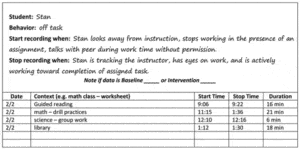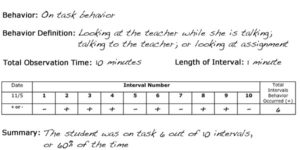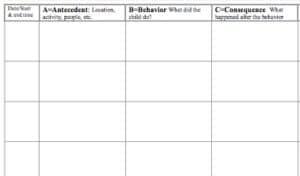Close your eyes and think of a behavior you’d like to see change in some way. It can be something you’d like to see increase or decrease. It can be something that your child, student, partner, friend, or even you do. Have you thought of something yet? Great! Hold on to that for a minute.
In the Clinical department at ASNC, every plan we create is different to meet the needs of each unique individual and family, and backed by evidence-based practices. However, all plans have a common thread: A good way to collect data for each behavior we are trying to address. Keeping track of when, how long, or how frequently a behavior occurs gives us an objective way to assess whether what we are doing is helping or whether we need to change something. It is one of the most important parts of any good program. There are lots of great reasons to take data, but being handed a complicated data sheet or finding a way to track data on your own can be intimidating and time-consuming! If you are looking for a better way to track progress at school or at home, below are some tips that can help.
Create a definition
The first thing to do when starting a data collection system is to come up with a good description of the behavior you are addressing. Think back to the behavior you came up with at the beginning of this article and objectively describe the behavior. Maybe you would like to see the number of tantrums at school decrease. The term for a behavior, such as “tantrum,” can mean different things to different people. What does a tantrum for your child look like? What specifically does the child do during the tantrum? A good description can help keep data clear and reliable, especially if multiple people are keeping track of the same behavior.
Make it easy to collect
Choosing how to collect data can often be a challenge. We want data collection to be easy enough that we will keep up with it, but sensitive enough that it gives us the right information. First think of what you are trying to learn and what method would work best. Below are a few data collection methods that are commonly used.
 Frequency: Measuring the number of times a behavior occurs within a given period. To use a frequency count, the behavior should be observable and have a clear beginning and end. For example, Eddie raised his hand five times during a one-hour class.
Frequency: Measuring the number of times a behavior occurs within a given period. To use a frequency count, the behavior should be observable and have a clear beginning and end. For example, Eddie raised his hand five times during a one-hour class.
 Duration: Recording the length of time that a behavior occurs. You may want to choose this method if your behavior lasts longer than a minute at a time. Sometimes, recording the duration of a behavior may give you better information than just recording the frequency of it. For example, if a student used to have one tantrum a day for 45 minutes but is now having three tantrums a day that are one minute long, a duration measure would show that tantrums have decreased dramatically, but a frequency measure would show an increase.
Duration: Recording the length of time that a behavior occurs. You may want to choose this method if your behavior lasts longer than a minute at a time. Sometimes, recording the duration of a behavior may give you better information than just recording the frequency of it. For example, if a student used to have one tantrum a day for 45 minutes but is now having three tantrums a day that are one minute long, a duration measure would show that tantrums have decreased dramatically, but a frequency measure would show an increase.
 Interval: This can be a shortcut for duration recording and can be really helpful in school. For this method, you set an interval (for example five minutes or an hour) and then you record whether the behavior occurred at all during that interval (partial interval recording) or whether it occurred for the entire time (whole interval recording). You can also set pre-determined times to check in and record whether the behavior occurred at that moment; this is called momentary time sampling. Interval recording can be as detailed or as broad as you need it to be. An example of very general interval recording would be “Did this behavior occur today? Yes or No.”
Interval: This can be a shortcut for duration recording and can be really helpful in school. For this method, you set an interval (for example five minutes or an hour) and then you record whether the behavior occurred at all during that interval (partial interval recording) or whether it occurred for the entire time (whole interval recording). You can also set pre-determined times to check in and record whether the behavior occurred at that moment; this is called momentary time sampling. Interval recording can be as detailed or as broad as you need it to be. An example of very general interval recording would be “Did this behavior occur today? Yes or No.”
 ABC data: When trying to understand the function of a behavior (i.e., why a behavior is occurring), we often will take ABC data. ABC stands for antecedent (what happened right before), behavior, and consequence (what happened right after). Taking ABC data can be very helpful to figure out why a behavior is happening, but sometimes it can be very time-consuming, especially if a behavior happens frequently. A way to make ABC data quicker to collect is to fill in common antecedents, behaviors, and consequences into each category, so that you can easily circle each item when the behavior occurs.
ABC data: When trying to understand the function of a behavior (i.e., why a behavior is occurring), we often will take ABC data. ABC stands for antecedent (what happened right before), behavior, and consequence (what happened right after). Taking ABC data can be very helpful to figure out why a behavior is happening, but sometimes it can be very time-consuming, especially if a behavior happens frequently. A way to make ABC data quicker to collect is to fill in common antecedents, behaviors, and consequences into each category, so that you can easily circle each item when the behavior occurs.
Make Data-Based Decisions
If you are taking data on a certain behavior, make sure you are consulting it often to make decisions. Day to day, we may not see dramatic changes in behavior, but the data we collect over time may reveal a different picture. Making data-based decisions helps us to be more objective and not make drastic changes based on how we feel in the moment.
Going back to the behavior that you thought of at the beginning of this post, I’m going to guess that many people first thought of something they want to see decrease (crying, tantrums, aggression) rather than something they would like to see increase (asking, turn-taking, smiling, playing). Taking data on challenging behavior is important, but keeping track of what we want to see instead is just as meaningful. A good definition of the targeted behavior, an easy and quick way to record what is happening, and analyzing the data often will help us make informed decisions.
Maggie Zoller, MA, BCBA, is an ASNC Clinical Professional in the Triangle region. ASNC’s Clinical Department staff is composed of PhD and master’s-level licensed psychologists, Board Certified Behavior Analysts, and former special education teachers. We provide individualized intensive consultation using evidence-based practices to support children and adults across the spectrum in home, school, employment, residential and other community-based contexts. We also deliver workshops to professionals on a wide range of topics including but not limited to, strategies to prevent and respond to challenging behaviors, best practices in early intervention, functional communication training, and evidence-based practices in instruction for K-12 students with autism.
To find out more, contact us at 919-865-5077 or clinical@autismsociety-nc.org.
Tags: ASNC, autism, autism asperger parenting tips, autism behavior, autism communication, autism education, autism resources, autism society north carolina, autism society of NC, Autism Society of North Carolina, Autism spectrum, Autism Spectrum Disorder, Autism Spectrum Disorders, autism treatment, special education Go back

